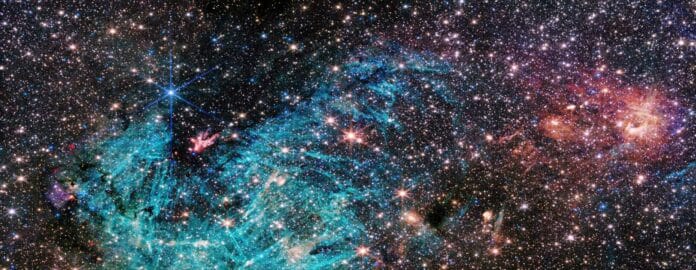Introduction:
NASA’s James Webb Space Telescope has treated astronomers with a breathtaking view of the dense center of our galaxy. It shows a portion of the dense center of our universe in unprecedented detail.
The star-forming region, Sagittarius C (Sgr C), is about 300 light-years away from the Milky Way’s central supermassive black hole, Sagittarius A*. Scientists now have access to an unprecedented degree of detail thanks to this image, which is helping them better comprehend star formation in extreme cosmic conditions.
Unveiling Unseen Features:
The observation team’s principal investigator, Samuel Crowe, an undergraduate student at the University of Virginia in Charlottesville, said, “There’s never been any infrared data on this region with the level of resolution and sensitivity we get with Webb, so we are seeing lots of features here for the first time. Webb reveals incredible detail, allowing us to study star formation in this environment in a way that wasn’t possible previously.”
Professor Jonathan Tan, one of Crowe’s advisors at the University of Virginia, said, “The galactic center is the most extreme environment in our Milky Way galaxy, where current theories of star formation can be put to their most rigorous test.”
Webb’s NIRCam (Near-Infrared Camera) instrument also captured large-scale emission from ionized hydrogen surrounding the lower side of the dark cloud, shown cyan-colored in the image. This results from energetic photons being emitted by young massive stars, but the vast extent of the region led by Webb is something of a surprise that bears further investigation.
Protostars in Action:
A cluster of protostars or stars still developing and acquiring mass, can be seen among the image’s estimated 500,000 stars. These stars produce outflows that burn like a blaze in an infrared-dark cloud. A previously undiscovered enormous protostar with a mass over 30 times that of the Sun lies in the center of this developing cluster.
Webb appears less crowded than it is because the cloud from which the protostars are emerging is so dense that Webb cannot receive light from the stars behind it. In reality, Webb is one of the most densely packed parts of the image. Tiny infrared dark clouds appear as holes in the starfield, scattered throughout the image. Future stars are forming there.
Galactic Center:
The galactic center is about 25,000 light-years from Earth, making it close enough to study individual stars with the Webb telescope. This has allowed astronomers to obtain previously unheard-of data on the formation of stars and how they may be influenced by the cosmic environment, particularly when compared to other galactic regions. Is there a greater formation of massive stars in the heart of the Milky Way compared to the outside areas of its spiral arms?
Rubén Fedriani, a co-investigator of the project at the Instituto Astrofísica de Andalucía in Spain, said, “The galactic center is a crowded, tumultuous place. There are turbulent, magnetized gas clouds that are forming stars, which then impact the surrounding gas with their outflowing winds, jets, and radiation. Webb has provided us with a ton of data on this extreme environment, and we are just starting to dig into it.”
Crowe said, “The image from Webb is stunning, and the science we will get from it is even better. Massive stars are factories that produce heavy elements in their nuclear cores, so understanding them better is like learning the origin story of much of the universe.”
